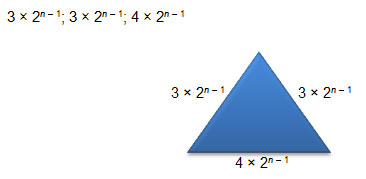![]() Use the interactive below to create a sequence of similar triangles. Use the results from the interactive to complete the table that follows and answer the questions.
Use the interactive below to create a sequence of similar triangles. Use the results from the interactive to complete the table that follows and answer the questions.
Copy and complete the table comparing the ratios of the lengths of the given sides of the triangles above into your notes or onto your own sheet of paper.
| Original Segment | ΔDEF | ΔGHI | ΔJKL |
| AB | DE over AB DE AB = | GH over AB GH AB = | JK over AB JK AB = |
| BC | EF over BC EF BC = | HI over BC HI BC = | KL over BC KL BC = |
| Original Segment | ΔDEF | ΔGHI | ΔJKL |
| AB | DE over AB DE AB = 6 over 3 6 3 = 2 | GH over AB GH AB = 9 over 3 9 3 = 3 | JK over AB JK AB = 12 over 3 12 3 = 4 |
| BC | EF over BC EF BC = 4 over 2 4 2 = 2 | HI over BC HI BC = 6 over 2 6 2 = 3 | KL over BC KL BC = 8 over 2 8 2 = 4 |

Interactive popup. Assistance may be required.
What patterns do you notice within each column?
Interactive popup. Assistance may be required.
The ratios of each pair of corresponding sides for each triangle as compared to ΔABC are equal.
Interactive popup. Assistance may be required.
An included angle is the angle between two sides of the triangle.
Interactive popup. Assistance may be required.
The included angles have the same measure.
Interactive popup. Assistance may be required.
What information do you have about corresponding sides and corresponding angles?
Interactive popup. Assistance may be required.
The given corresponding sides are in proportion and since the sides are in proportion and the included angle is a right angle, and all right angles are congruent. This satisfies SAS Similarity Theorem.
Interactive popup. Assistance may be required.
The scale factor is the multiple used to multiply the side lengths of ∆ABC in order to generate the new triangle.
Interactive popup. Assistance may be required.
The scale factor is equal to the triangle number.
Interactive popup. Assistance may be required.
What would be the scale factor for Triangle 7?
Interactive popup. Assistance may be required.
3 meters × 7 = 21 meters; 2 meters × 7 = 14 meters
Interactive popup. Assistance may be required.
What would be the scale factor for Triangle z?
Interactive popup. Assistance may be required.
3z meters and 2z meters
Inductive reasoning is a thought process by which rules are generated from observations of patterns. How did you use inductive reasoning to generate your expression to determine the lengths of the legs of Triangle z in the sequence of similar triangles above?
Use the information below about a sequence of similar triangles to answer the questions that follow. You may want to sketch the triangles to help you answer the questions.
Triangle 1: 3 cm, 3 cm, 4 cm
Triangle 2: 6 cm, 6 cm, 8 cm
Triangle 3: 12 cm, 12 cm, 16 cm
Triangle 4: 24 cm, 24 cm, 32 cm
Interactive popup. Assistance may be required.
What factor do you need to multiply the lengths the sides of Triangle 1 by in order to generate the lengths of the sides of the other triangles?
Interactive popup. Assistance may be required.
Triangle 2: scale factor = 2
Interactive popup. Assistance may be required.
How are the numbers 2, 4, and 8 related?
Interactive popup. Assistance may be required.
The scale factor is a sequence of powers of 2.
Interactive popup. Assistance may be required.
Write the scale factors as powers of 2 using exponents.
Interactive popup. Assistance may be required.
Triangle 2: scale factor = 2 = 21
Interactive popup. Assistance may be required.
What are the next numbers in the sequence of scale factors?
Interactive popup. Assistance may be required.
Triangle 5: scale factor = 24 = 16
Interactive popup. Assistance may be required.
If the triangle number is n, what power of 2 do you need to use for the scale factor?
Interactive popup. Assistance may be required.

